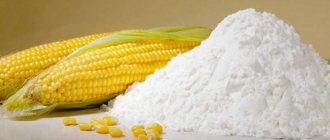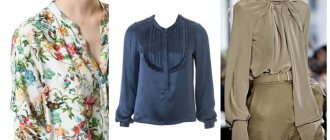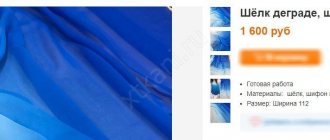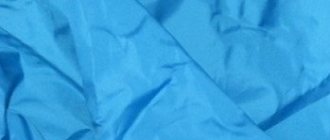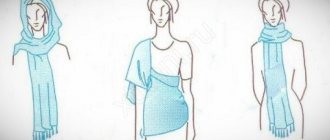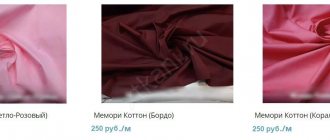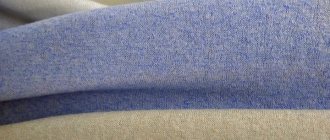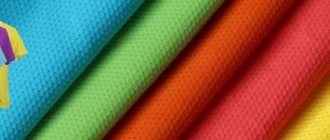History of origin
Appearing back in the 14th century, poplin was originally a slightly rough but pleasant-to-touch mixed fabric based on silk and wool fibers. The special softness and density made the fabric an element of the attire of the upper classes.
The unusual name of this fabric has a whole history - in medieval Avignon, where the technology for producing this functional and spectacular material originates, the residence of the Pope was located. Vestments for clergy were also sewn there, for which poplin was well suited due to its shape stability and attractive appearance. The fabric we know as “poplin” (from the French popeline or Italian papalino) was simply called “papal”.
- Poplin appeared in Russia much later - only at the beginning of the 18th century under the name “European calico”. At first it was imported exclusively from European countries, but later the manufacturing technology was mastered by Russian weavers. In Soviet times, poplin began to be produced en masse in our country.
What poplin looks like and its weave types
Thin but dense (100-110 g/m2), holding its shape well, suitable for both simple and sophisticated silhouettes, poplin is easy to recognize at first sight. The main feature of the material is the type of weave that forms a small characteristic scar on the surface of the fabric. Up close, you can even see exactly how the threads are connected into the fabric.
The technology for making poplin involves machine-made plain (poplin) weaving of thin warp fibers with thick weft threads, 2 times thicker than for the warp, and the fibers are pressed as closely as possible to each other. The result is a strong and wear-resistant fabric with a soft “reps” surface (dense fibers are “wrapped” in many soft threads).
Varieties of poplin by composition
The most commonly used material in clothing production today is 100% cotton poplin , woven from threads of two different thicknesses. This material is used both for individual tailoring and on a large production scale. An example of quality cotton poplin is Grodesin, which is made from premium quality raw materials in India. Pakistani and Turkish cotton are also excellent for making poplin.
Traditionally, poplin was made from silk fibers; today this technology is used only locally, not on a large scale, due to the high cost of silk raw materials. At the same time, modern technological options are appearing that are not inferior in many characteristics to material with a centuries-old history. Today's analogue of classic silk poplin for tailoring is poplex, a fabric in which a thin and dense cotton base is combined with rare thick synthetic weft threads. Poplex may vary in density and other characteristics, but its cotton content cannot be less than 40%.
To make bed linen in the middle price segment (for the luxury class, only 100% natural ones are chosen, they are denser and softer), another variety of this functional fabric is used - macopoplin or polycotton (polysatin). What kind of material is this? A blend of e-cotton and polyester that, thanks to its synthetic fiber content, holds bright colors well. Also popular are sets of adult and children's bedding made from polypoplin, another mixed variation of the material; according to reviews, products made from it are pleasing with their practicality.
Stretch poplin is a clothing material made of cotton with the addition of lycra. This fabric stretches a little, does not prick, and products made from it fit perfectly to your figure.
There are also types of poplin such as header, extra, elegans.
Recommendations for selection
Regardless of the place of production, poplin is the same in its properties and quality.
When they try to force you to buy a sleeping set made of polypoplin, do not rush to purchase an “innovative development”. Polypoplin is a fabric containing a lot of synthetics.
Some manufacturers add synthetic fibers to increase wear resistance and reduce cost, but do not always indicate this fact on the label.
This fabric is easy to wash , dries quickly, but does not absorb water well, is not too soft to the touch and is quite dangerous for allergy sufferers.
The main proven manufacturers, using only high-quality raw materials and modern sewing technologies, are ArtPostel, GOLDTEX, Valtery, Charming Night, SayliD, Cleo and Domus. Ivanovo Poplin produces beautiful and very high-quality fabrics that are affordable.
Poplin fabric is very difficult to wrinkle, so crumple the corner in your hand before purchasing.
A solid label and high cost do not at all guarantee the highest quality of the product. It is necessary to consider the quality of tailoring of the set, which should not have uneven edges or protruding threads. Good bed linen is usually made from solid linen.
Varieties of poplin by dyeing method
The color range of modern fabrics, grouped under the “poplin” category, is very diverse. These include plain, printed, and multi-colored fabrics. The following types of poplin differ in the method of dyeing:
- Bleached fabric . A significant part of fabrics with a natural composition undergo the bleaching process - initially such fibers have a natural yellowish, gray tint. Numerous chemicals are used, which are subsequently washed out of the fibers with an alkali solution. As a result, the fabric acquires not only an amazing white shade, but also additional hygroscopicity and a light matte shine.
- With a printed (printed) pattern . Using special printing devices, the design is applied to the fabric using digital printing or airbrushing. Printed fabrics hold small and bright elements of the design well and are safe even for the little ones. Things from them turn out noticeable and unusual.
- Plain-dyed poplin is one of the most common. In this case, an already bleached fabric is dyed; during the process, the fabric is dyed and washed several times, ensuring that the dye is resistant to fading.
- Multicolored material . Such fabric, with a striped or checkered pattern, is obtained if it is woven from already dyed threads.
Pros and cons of poplin
Despite the fact that poplin today has many composition options, the most popular option is still a soft and shape-resistant medium-density cotton material. What differences does it have from other types of cotton, what are its advantages and disadvantages?
Let's start with the positives.
- The softness and comfort of poplin are qualities that make it chosen for sewing summer, body-friendly clothing and bed linen.
- Thanks to its natural composition, the fabric has excellent breathability and hygroscopicity, which means it is characterized by proper thermoregulation.
- Despite its high strength and significant wear resistance, the fabric has a medium density and is suitable for underwear.
- Poplin is a material suitable for those with delicate skin and those who are especially sensitive to the composition of the fabric. In particular, it is well suited for both allergy sufferers and people with atopic skin in remission.
- The fabric, due to the fact that it consists of high-quality cotton, is easy to care for and unpretentious to use. Does not fade, does not shrink, and after ironing it retains its perfect appearance until the next wash.
- Thanks to the use of plain weave technology and different fiber diameters, poplin is textured and wrinkle-resistant.
Poplin has very few disadvantages, and if you encounter them, this will be a sign of choosing a low-quality product. The difference in comparison with a worthy example will be obvious. Poplin woven in violation of technology or from poor raw materials quickly becomes frayed, shrinks, puffs form on it, and it may even lose color. If low-quality dyes are used, there may even be a noticeable chemical smell from the fabric.
All this can be avoided if you buy poplin in trusted places - from manufacturers who have repeatedly proven their approach to work, with quality checks for each batch. Poplin may have different names on its label; the most common are cotton and poplin.
Poplin for bed linen
Almost all types of fabric are comfortable for the skin, which is why poplin is widely used in the production of bed linen. Its strength and softness are comparable to calico bedding sets. Poplin, like other fabrics, “breathes”, retains heat and allows water to pass through.
Poplin bedding most often consists of pure cotton, but sometimes silk, wool and synthetic threads are woven into the fabric, on which the price of the product ultimately depends.
What is made from poplin
Many years have passed since the synthetic revolution swept across the world, and gradually the excitement around artificial fabrics is calming down. Everyone understood that in clothing, as in everything else, a balanced approach and reasonable choice are important. For some purposes, practical and affordable synthetic-based materials are better suited; for other purposes, eco-friendly fabrics are better suited. Poplin has returned to fashion - some models using it have become noticeable trends, others fit well into capsules for a basic wardrobe. What are they sewing from different versions of this fabric today?
Despite the fact that poplin cannot be unambiguously called a dress fabric, current dresses - fluffy, tiered, with puffed sleeves - made from poplin are very impressive. Considering that this fabric is hygienic, in the summer it is difficult to find a more convenient option for walking around the city, photo shoots or gatherings in a cafe. Skirts and jackets, tops with complex designs - cotton material copes with a variety of tasks perfectly.
This fabric will also enrich a man's summer wardrobe - stylish shirts or relaxed holiday shorts are indispensable in the warm season. Thin poplin is considered the ideal shirting material, strong, smooth and suitable for layering, it is stronger than regular cotton.
Poplin will also fit into children's looks - oversized is now popular, and the current silhouettes of girls' dresses are looking more and more voluminous. Plain weave fabric has enough density and lightness to give the desired effect. In addition, stains are easily removed from poplin with regular washing, and children can walk without fear of getting dirty.
Of course, we can’t help but mention bedding, which is made from poplin and is very comfortable, durable, and easy to use. This good fabric is also very popular for home textiles - tablecloths, pillowcases for decorative pillows.
What are the main differences?
What material is better for bedding? Against the backdrop of numerous general advantages, several distinctive features can also be considered:
- Interweaving of fibers. In the production of satin, satin weaving is used, the same can be said about poplin fabrics. This feature clearly affects the visual characteristics of fabrics. Satin is smooth and matte
- Thickness and density. Poplin fabrics are thinner and much lighter. Satin-jacquard and mako-satin are distinguished by their greater weight and high density.
- Strength. Satin is more durable and durable.
- Price. Poplin bed linen is much cheaper compared to the most affordable options for satin linens.
To decide on one of the two types of materials, it is advisable to familiarize yourself with the features of caring for them.
How to sew from poplin?
Working with poplin based on premium cotton is a pleasure! The material does not slip on the table at all during cutting and sewing by hand or on a machine, and is resistant to creases.
- Important ! Before cutting the fabric, decating is necessary.
You can then follow the simple steps to create a new product.
- When cutting and basting parts, connect the layers of fabric with thin pins, this will prevent the fabric from shifting during work.
- We recommend using pencils with water-soluble ink as a marking and marking tool. If you choose chalk, test it on a small piece of material first to avoid any greasy marks.
- Select the appropriate needle and presser foot for your machine. Cotton poplin is quite dense, but sometimes, if selected incorrectly, the needle can leave noticeable holes on the surface of the fabric. Which needle is suitable? We recommend fine, sharp needles that are compatible with your machine.
Caring for poplin products
Cotton poplin is surprisingly unpretentious. Almost any contaminant can be removed from its surface - in general, the recommended water temperature for washing is 40 degrees, but washing in hotter water, up to 60 degrees, is also allowed. If the stains are still not washed off, light, plain poplin can even be boiled.
Spinning at medium and maximum speed will allow you to get almost dry laundry after washing. If additional drying is required, choose options in a shaded area outdoors or in a well-ventilated area.
The canvas practically does not wrinkle, but if there is a need to refresh the look of poplin clothes, select the “cotton” mode on your iron.
Care instructions
In order not to spoil your favorite poplin item, you need to wash it in a gentle cycle, in water with a temperature of up to 30 degrees.
Before washing, the product is turned inside out to preserve the design longer. Noble poplin does not tolerate aggressive powders and bleaches.
Poplin dries perfectly without spinning, while retaining its best qualities. Dry the products in the shade, then their design will last longer.
How to choose poplin?
The modern fabric market is saturated with offers for every taste. With a variety of options, how can you decide and get those materials that will become an excellent basis for your custom-tailored clothing and home textiles?
You recommend fabrics from trusted foreign manufacturers. Poplin made from long-staple cotton from the leading plantations on the planet from our suppliers - a large selection of fabrics of various densities, with different color options from laconic to trendy. We have both basic items and exclusive ones with current designs.
Detailed descriptions and detailed photos indicating the scale of the print will be useful for buyers. They will help you make a choice in favor of materials that exactly suit your needs. The width and cost per linear meter are also indicated in the product cards. There is a convenient sorting by price, you can choose more expensive and cheaper products. Prompt delivery in a convenient way is a nice bonus for those who love quick sewing projects.
Our fabric catalog
Reviews
promokashka. Anyone who has already tried poplin underwear will be looking for something similar for something new. The big plus is that it is natural, 100% cotton. It is hypoallergenic, and this is important for many now. The fabric is very pleasant to the touch, smooth and soft. In winter, when the apartment is not hot, the bed when you lie down does not seem so cold, perhaps because of the same softness, I think. It does not wrinkle much, i.e. Everything wrinkles, but the poplin retains its decent appearance and it’s not very noticeable. It washes perfectly, the design does not lose its brightness for a very long time. Ironing is easy, although I don’t do it often myself, the main thing is to dry it evenly and fold it right away.
Lenore. I once bought poplin bed linen on the advice of the woman who ordered it for me; before that they only bought calico. To be honest, I don’t understand fabrics, but here, as they say, the results are obvious. The fabric is very pleasant to the body, the color has not changed at all after washing, the linen is stronger than calico and at the same time softer. By the way, we took a family set for 1300, although before that we paid one and a half for calico, I was very pleased, now I want to take a couple more, because we have a lover of tearing up sheets(
hoht. When I bought poplin bed linen, I was attracted by the fact that it was 100% cotton. I bought it as a gift and liked the large selection of colors. I also took a set for myself. Everyone is happy with this underwear. Only one minus is that you need to wash at 30 degrees. This means that you need to wash it separately and do not forget to switch the temperature.

